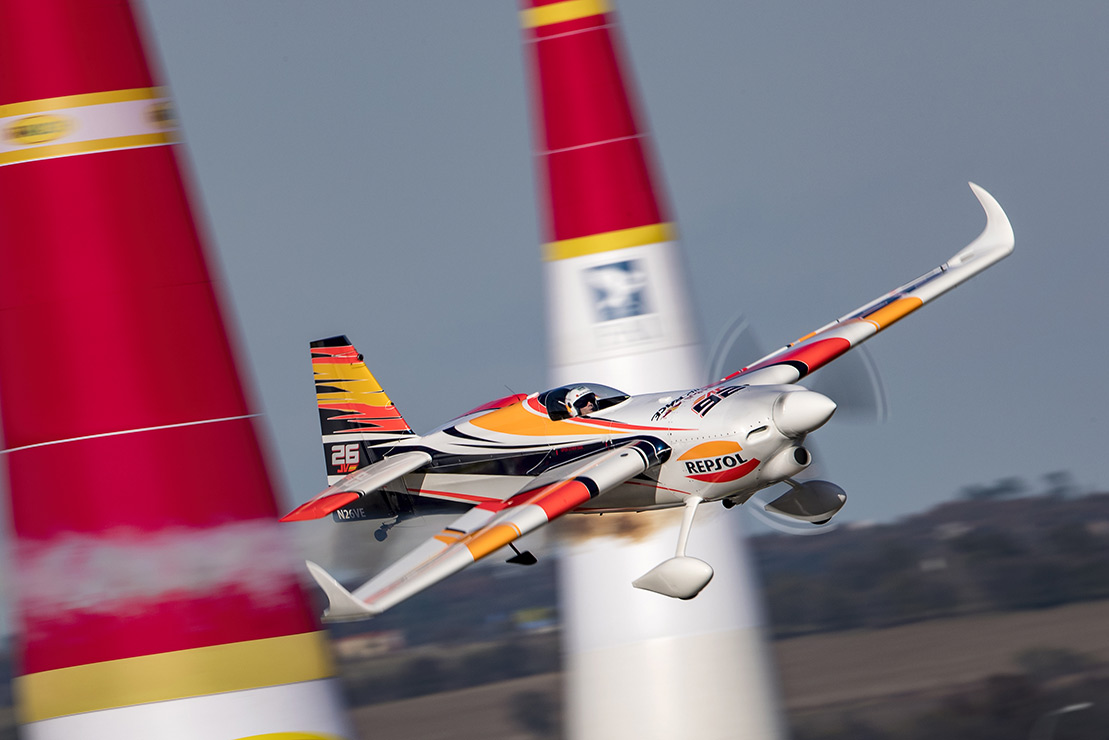Being a pilot in the Red Bull Air Race, the fastest air competition, is not something that everyone can do. In a race you have to withstand more than 10G during the flight. That means that a 75 kg pilot can weigh up to 900 kg during an especially tight turn. When this happens, the hands and feet become much heavier, so that moving them to control the aircraft with the precision required is extremely difficult.
And precision is everything in this sport. The pilots have only a few milliseconds to put the machine in the right positions to follow the course, not forgetting that this involves the three directions of the plane (up, sideways, and forward), which are controlled by three types of elements. We should also not forget to make sure that the engine is responding correctly to each manoeuvre, and the blades of the propeller are facing in the right direction. As if this were not enough, the pilot also has to keep an eye on all the instrumentation on the plane to ensure that everything is operating smoothly.
Fortunately, the EDGE 540 V2 does not have some systems that are normal on planes of this type and that add more complications to the equation, such as flaps, retractable landing gear, and more than one engine.
To steer the craft there are two main controls, the joystick and the pedals.


The joystick
The joystick sits between the pilot’s legs and with it he can make two changes to the flight attitude. The first is pitch, which changes the front to back angle of the plane. In other words, it raises or lowers the nose of the plane to gain or lose altitude. The joystick communicates with the elevator on the horizontal edge of the tail, which moves by pulling the stick towards the pilot to raise it or pushing it forward to lower it.
If the joystick is moved to left or right, this affects the position of the ailerons on the wings. This affects the side-to-side movement, also called roll. This tilts the plane to the left or right causing it to turn. This is one of the most critical controls on the EDGE 540 V2, as the plane can turn 420° per second if the joystick is pushed as far as it will go.
The Pedals
The rudder, which is on the tail of the plane, is used to correct, adjust or centre the direction of the plane. It is vertical and is controlled with the pedals. If the pilot presses the left pedal, the aeroplane will turn to the left in the vertical axis, and vice versa. This movement is called yaw, and though it may appear that it is used to turn the plane, it barely affects the turn and is used to complement roll.





Staying orientated when in the air
When you are flying, and even more so in an acrobatic plane, your position is constantly changing. If you turn through 90° from any of the axes, the controls that handle the horizontal dimension start to control the vertical dimension and vice versa.
It is very important to have a good sense of orientation and be able to adapt the movements of the joystick and pedals to the rapid changes that occur during a race. When the plane is flying the course, it must avoid the pylons, which appear in extremely rapid succession, while at the same time going through the gates with the machine completely level. The smoke given off during the flight gives you an idea of the precision with which the pilot is handling the machine. If the trail follows the same direction as the plane, you know that the control is ideal.





Safety First
Before even getting into the plane, the pilot must check that everything is in good condition. First of all, he goes around the plane, checking the various items like the propeller, sensors, control surfaces, fuel levels, and lubricant levels. Any damage or anomaly detected at this point must be repaired before he continues.
Once he is in the cabin, he checks the instrumentation and that the controls move freely, following a checklist in the plane’s manual. After checking all these, buckling up and closing the canopy, he switches on the engine and taxies to the runway for take-off. During this time, he checks the brakes and all the instrumentation linked to the engine.
On the runway he again checks that the control surfaces move freely and checks the flight instruments, fuel selector, and gauges. After receiving the OK from the control tower, the pilot accelerates gently to maximum power and takes off at a speed of approximately 70 knots.





Getting to fly in the Master Class of the Red Bull Air Race is a feat that few can achieve, among them the Spanish pilot Juan Valverde. Follow his results and the competition calendar on Box Repsol.


 Join Us
Join Us  Join Us
Join Us 